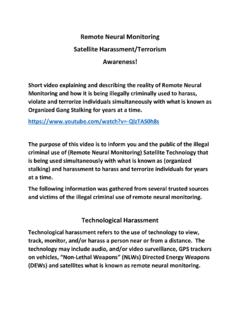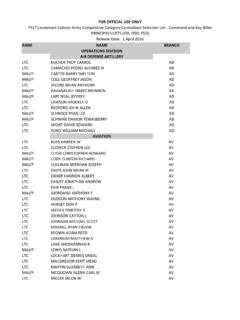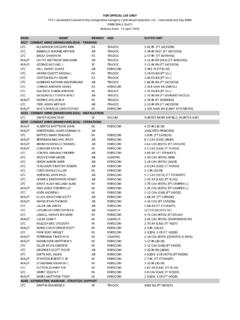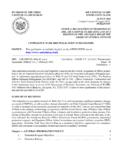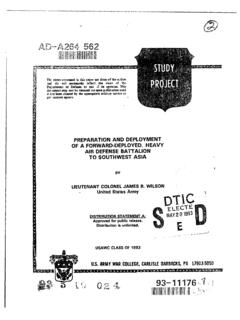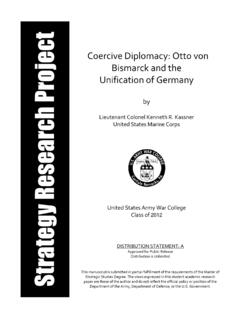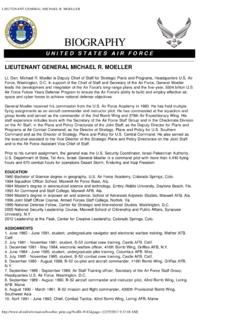Transcription of HIGH POWER RADIO FREQUENCY WEAPONS: A POTENTIAL …
1 high POWER RADIO FREQUENCY weapons : A POTENTIAL COUNTER TO STEALTH AND CRUISE MISSILE TECHNOLOGY by John A. Brunderman, lieutenant colonel , USAF Center for Strategy and Technology Air War Col lege Air University Maxwell Air Force Base, Alabama December 1999 Disclaimer The views expressed in this publication are those of the author and do not reflect the official policy or position of the United States Government, Department of Defense, or the Air War College Center for Strategy and Technology. ii Contents Page DISCLAIMER ..ii INTRODUCTION A 1 Beam Microwave Target Susceptibility .. 13 Area Coverage .. 16 Ins ensitivity to Weather .. 16 Reduced Life Cycle 17 CONSTRAINTS.
2 19 Range .. 19 Targeting and Survivability .. 21 PROLIFERATION CONCERN .. 22 RF weapons IN AN AIR DEFENSE 25 PROTECTIVE MEASURES .. 28 iii Illustrations Page Figure 1: Example of an Antenna Pattern .. 21 Figure 2: Diagram of Former Soviet Union's Antiaircraft Microwave Weapon Figure 3: Effect vs Range for Multiple Targets .. 31 Figure 4: Effect vs Range for Multiple Devices .. 31 iv Tables Page Table 1: Possible RF/Microwave Protective Techniques .. 29 v Abstract The emergent technology of high POWER RADIO FREQUENCY in a directed energy role has huge POTENTIAL for military use, in both offensive and defensive roles. There are many applications for this type of technology, from minesweeping to anti-aircraft artillery to unmanned combat aerial vehicles.
3 Given the current dominance in precision attack and air combat capability, new technologies might serve to challenge this advantage if an enemy can exploit them. This paper examines the question of whether tactics or strategy will have to change with these systems in the hands of an adversary, assuming they were used in an integrated air defense role to counter high -tech deep-strike capa bility. Specifically, could high POWER microwave systems become an effective defense against our standoff cruise missile and stealth technology and if so, could an adversary develop and deploy them without our knowledge in order to catch us unaware?
4 Based on the findings, the conclusion recommends several avenues that the Air Force should pursue to prepare for these future weapons . vi Chapter 1 Introduction A Scenario The news agencies had been covering the diplomatic negotiations for days. The ultimatum had passed hours before and everyone knew that air strikes were inevitable. Although the networks did not know the exact timing, they had placed daring reporters in country to capture the spectacular effects expected of precision weaponry. They had eve n contracted for satellite imagery from the numerous commercial systems ava ilable. The whole world sat on the edge of their seats to see how this would turn out.
5 Everything was planned perfectly. The simultaneous attack of communication nodes, command structures and the Int egrated Air Defense System (IADS) with deep- strike precision cruise missiles and stealth bombers would set the stage for all that would come after. The enemy would eithe r capitul ate or suffer the piecemeal dismantlement of his entire infrastructure. The first weapons should be reaching their targets just about Something was seriously wrong. CNN was reporting numerous explosions in business and residential areas of the city. The pictures of disfigured and bloodied men, women and children paraded across the screen.
6 A CNN news crew had been killed in one of the explosions. Air Operations Center was reporting two downed B-2s. Satellite imagery was just coming in. It confirmed that scores of cruise missiles had missed their 1 targe ts and landed in civilian areas. SIGINT reports showed the IAD system still operational. The talking heads were screaming about war crimes for attacking civilian population centers. You call off the second wave of manned bombers. You wonder what you missed when your Aide informs you that the White House is on the phone. The above scenario is a nightmare for any American commander. In a world of instant communications, even small tactical events can often take on strategic significance.
7 Recent trends toward political aversion to the realities of combat, in particular the sensitivity toward casualties, are placing incredible constraints on the military commander and giving our adversaries leverage to use against the United States. In the Gulf War, the destruction of an underground command and control bunker that was also being used as an air raid shelter by the civilian populous sparked an outcry in the West and a change in coalition targeting. In Kosovo, after the accidental bombing of the Chinese embassy, the alliance imposed a moratorium on bombing in As of this writing, the incident is still causing problems in relations.
8 When an F-117 pilot was shot down over Serbia, almost the entire Kosovo air effort was diverted into search and rescue operations until he was picked up. Should an adversary ever devise the means to signi ficantly increase our own casualty rates or even precipitate our killing of their civilians, intentionally or not, they have a good chance of altering the course of the war, especially in small scale conflicts where national survival is not at stake. high POWER RADIO FREQUENCY weapons are a new technology on the horizon that might provide just such a means. The scientific and military communities have known of the potentially damaging effects of RADIO FREQUENCY (RF) energy on electronics since the advent of radar.
9 During 2 the Vietnam War, in Jul y 1967, investigators determined that the energy from the USS For restal s main radar caused a devastating explosion when it penetrated faulty shielding in an air-to-air missile loade d on an F-4 fighter aircraft. The resulting damage ultimately cost the lives of 134 sailors and took seven months to Even after this affair, the put little effort into exploring this phenomenon for military use, except in basic research. The Soviet Union, however, had been seriously pursuing RF weapons research starting as early as 1949 and continued to do so. It was not until after President Reagan s announcement of his Strategic Defense Initiative (SDI) in March of 1983, coming on the heels of significant Soviet advancement in RF/microwave weapon technology in the late seventies, that the began its own push in this Since then, advances in high POWER RF/microwave (HPM) generation capability have been coming regularly.
10 The United States is cur rently developing operational systems in an attempt to capitalize on these discoveries. The former states of the Soviet Union, particularly Russia and Ukraine, have continuing programs in thi s area and are freely sharing their knowledge with those who can pay for it. Reports indicate that France, Germany, Chi na, India and even Pakistan have invested in RF technology from the former Soviet Union. There are many applications for this type of technology, from minesweeping to artillery, to unmanned combat attack vehicles. The question before us is whether military tactics or strategy must change with these systems in the hands of an adversary.


